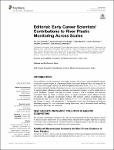Editorial: Early Career Scientists’ Contributions to River Plastic Monitoring Across Scales
| dc.contributor.author | van Emmerik, T | |
| dc.contributor.author | González-Fernández, D | |
| dc.contributor.author | Mendrik, F | |
| dc.contributor.author | Biermann, L | |
| dc.contributor.author | Drummond, J | |
| dc.contributor.author | Liedermann, M | |
| dc.date.accessioned | 2023-12-19T13:52:48Z | |
| dc.date.available | 2023-12-19T13:52:48Z | |
| dc.date.issued | 2023-03-25 | |
| dc.identifier.issn | 2296-6463 | |
| dc.identifier.issn | 2296-6463 | |
| dc.identifier.uri | https://pearl.plymouth.ac.uk/handle/10026.1/21817 | |
| dc.description.abstract |
Plastic pollution in aquatic ecosystems (rivers, lakes, estuaries, and oceans) is of growing global concern, because of its negative impact on environmental health, and human livelihood. Rivers are assumed to be one of the main transport pathways for land-based plastics from source to sea (Meijer et al., 2021). Yet, observations and understanding of riverine plastics are scarce in comparison to the marine environment. To optimize plastic pollution prevention, mitigation and reduction strategies, as well as reliable data on plastic abundance, transport, and types are crucial. However, a lack of consistent and long-term observations limits our ability to monitor plastics in aquatic ecosystems. Recent advances in both cost-effective and high-tech measurement methods, that promote method standardization and harmonization, may be key to tackle plastic pollution (UNEP, 2020). This Research Topic bridges the gap between 1) macro- and microplastics, 2) fundamental research and development of long-term monitoring strategies, 3) in situ and remote sensing observations, and 4) observation-based modelling approaches to link scales and ecosystems. | |
| dc.format.extent | 861531- | |
| dc.publisher | Frontiers Media SA | |
| dc.subject | 37 Earth Sciences | |
| dc.subject | 3709 Physical Geography and Environmental Geoscience | |
| dc.subject | 3705 Geology | |
| dc.subject | 3706 Geophysics | |
| dc.title | Editorial: Early Career Scientists’ Contributions to River Plastic Monitoring Across Scales | |
| dc.type | journal-article | |
| dc.type | Editorial | |
| plymouth.volume | 10 | |
| plymouth.publisher-url | http://dx.doi.org/10.3389/feart.2022.861531 | |
| plymouth.publication-status | Published online | |
| plymouth.journal | Frontiers in Earth Science | |
| dc.identifier.doi | 10.3389/feart.2022.861531 | |
| plymouth.organisational-group | |Plymouth | |
| plymouth.organisational-group | |Plymouth|Faculty of Science and Engineering | |
| plymouth.organisational-group | |Plymouth|Faculty of Science and Engineering|School of Biological and Marine Sciences | |
| plymouth.organisational-group | |Plymouth|REF 2021 Researchers by UoA | |
| plymouth.organisational-group | |Plymouth|Users by role | |
| plymouth.organisational-group | |Plymouth|Users by role|Academics | |
| plymouth.organisational-group | |Plymouth|REF 2021 Researchers by UoA|UoA07 Earth Systems and Environmental Sciences | |
| plymouth.organisational-group | |Plymouth|REF 2028 Researchers by UoA | |
| plymouth.organisational-group | |Plymouth|REF 2028 Researchers by UoA|UoA07 Earth Systems and Environmental Sciences | |
| dcterms.dateAccepted | 2022-03-01 | |
| dc.date.updated | 2023-12-19T13:52:48Z | |
| dc.rights.embargodate | 2023-12-20 | |
| dc.identifier.eissn | 2296-6463 | |
| rioxxterms.versionofrecord | 10.3389/feart.2022.861531 |


